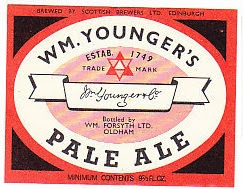In certain styles of beer – Light Pale Ales, for example – a light body and pale colour were desired characteristics. The use of adjuncts and sugar were the only way to achieve the characteristics expected by drinkers.
In the immediate aftermath of the 1880 legislation, brewers experimented with a few different possibilities. Barclay Perkins, for example, at first went for flaked rice. Eventually, however, they settled on flaked maize, as most other brewers did. And, the difficult years of WW I excepted, brewers mostly stuck with maize right up until WW II.
The percentage of adjuncts employed varied according to the style and the brewery, but 10-15% was pretty typical. Some breweries never went down the adjunct route, except when compelled during the war years. Whitbread, for example, who only used malt and sugar.
During the war, the type of adjunct used varied, presumably dependent on the availability of supplies. The first change came pretty early, in spring 1940 when I can see in brewing records that flaked rice replaces flaked maize. Fullers, Tetley, Boddington. It can’t be a coincidence.
The next adjunct to appear is flaked barley, something that was unknown pre-war. It was make practical by a big increase in UK barley production during the war. Despite being of malting quality, some was flaked to save labour and energy.
Early in 1943, brewers were asked to use flaked oats rather than flaked barley, which, owing to the poor supply of grain, was needed for bread. But that phase was brief and in the final years of the war flaked barley was king.
Fullers X Ale grists are pretty typical in the adjuncts employed at different phases of the war.
| Fullers X Ale adjunct usage 1939 - 1946 | |||||
| year | flaked maize | flaked rice | grits | flaked barley | flaked oats |
| 1939 | 14.78% | ||||
| 1940 | 9.72% | 1.94% | |||
| 1941 | 14.28% | ||||
| 1942 | 13.77% | ||||
| 1943 | 6.91% | 7.54% | |||
| 1944 | 14.82% | ||||
| 1945 | 15.10% | ||||
| 1946 | 14.55% | ||||
| Source: | |||||
| Fullers brewing records held at the brewery | |||||
As soon as everything got back to normal in the 1950s, brewers returned to their preferred adjunct, flaked maize.



















































































